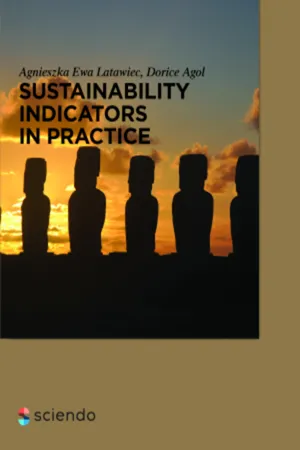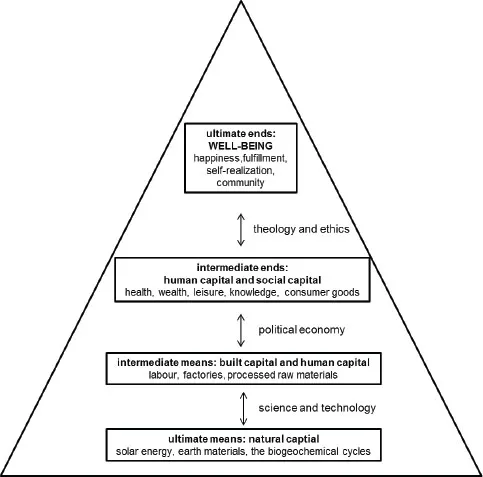
- 271 pages
- English
- ePUB (mobile friendly)
- Available on iOS & Android
Sustainability Indicators in Practice
About this book
The goal of sustainable development is to meet the socio-economic and environmental objectives without comprising the needs of future generations. Since the Rio Summit of 1992, the concept of sustainability has captured our imaginations and aspirations and efforts to develop its indicators have increased. A range of sustainability indicators have been developed within various socio-economic, environmental and cultural contexts- including biodiversity, economy, energy, water, land use and transport. Sustainability indicators are widespread in international development arena. They have become popularized among governments, non-governmental organizations, private sector and the wider public.
Based on multiple cases across the world, this book explores opportunities and challenges associated with the practical application of sustainability indicators. The book reflects diversity of professionals of inter-disciplinary backgrounds covering contemporary issues within different socio-economic and environmental contexts. Each chapter presents practical examples of the merits and challenges of using sustainability indicators and draws conclusions and lessons learned. The book targets a range of audience from students, academics to development practitioners and policy-makers.
The two editors of this book: Dr. Agnieszka Ewa Latawiec and Dr. Dorice Agol are inter-disciplinary scientists who both have experience in research at the environmental conservation and development nexus.
Frequently asked questions
- Essential is ideal for learners and professionals who enjoy exploring a wide range of subjects. Access the Essential Library with 800,000+ trusted titles and best-sellers across business, personal growth, and the humanities. Includes unlimited reading time and Standard Read Aloud voice.
- Complete: Perfect for advanced learners and researchers needing full, unrestricted access. Unlock 1.4M+ books across hundreds of subjects, including academic and specialized titles. The Complete Plan also includes advanced features like Premium Read Aloud and Research Assistant.
Please note we cannot support devices running on iOS 13 and Android 7 or earlier. Learn more about using the app.
Information
1 What Are Sustainability Indicators For?
1.1 Introduction
1.2 Components And Interpretations Of Sustainability
- – Natural capital is the quantity and quality of environmentally provided assets (such as soil, atmosphere, forests, water, wetlands, mineral resources, biogeochemical cycles, etc.) that provide a flow of useful goods or services (Serageldin, 1996). The “ecosystem services” provided by natural capital include provisioning of food, water, timber, and fiber; regulating climate, floods, disease, wastes, and water quality; culturally related recreational, aesthetic, and spiritual benefits; as well as soil formation, photosynthesis, and nutrient cycling processes that support other natural capital services (MEA, 2005). Natural capital can also be perceived as the ultimate, non-substitutable stock underlying all other capital stocks (Daly, 1991; Meadows, 1998). Humans can build a water filtration plant to provide the same services as a forest, but we cannot create water out of nothing.
- – Human capital is the quantity of the human population (size, age structure and geographic distribution), and the quality (health and capability) of that population (Serageldin, 1996).
- – Knowledge capital includes collective public awareness of how and why things are as they are (formal scientific knowledge) as well as how to fulfill human purposes in a specifiable and reproducible way (experiential technological and managerial knowledge) (Brooks, 1980; Raymond et al., 2010). The components of human and knowledge capital defined here are often combined under the heading of human capital.
- – Social capital encompasses norms and institutions and emerges from interactions between people or between people and organizations or the market. Institutions include official policies as well as informal rules, while norms include expectations about behavior, such as reciprocity and trust (Ostrom, 1986; Roseland, 2000; Ostrom, 2009).
- – Manufactured capital is the quantity and quality of physical stock that is created by humans, to provide goods and services, such as roads, houses, machinery, cars, and medicine (Serageldin, 1996).

1.3 Why Do We Need Sustainability Indicators?
Table of contents
- Cover
- Half Title
- Title Page
- Copyright
- Contents
- Foreword
- Acknowledgments
- Cover photo – Easter Island
- Introduction - Why Sustainability Indicators In Practice?
- 1 What Are Sustainability Indicators For?
- 2 Understanding Indicators And Monitoring For Sustainability In The Context Of Complex Social-Ecological Systems
- 3 Biodiversity Indicators And Monitoring For Ecological Management
- 4 Monitoring REDD+ Impacts: Cross Scale Coordination And Interdisciplinary Integration
- 5 Measuring Indicators For Sustainable River Basin Management
- 6 Sustaining Local Livelihoods Through Coastal Fisheries In Kenya
- 7 Peninsular Pronghorn Conservation: Too Many Paradigms, Too Few Indicators
- 8 Restoration Success Of Tropical Forests: The Search For Indicators
- 9 Sustainability Indicators In Brazilian Cattle Ranching
- 10 Sustainability Indicators For Agriculture In The European Union
- 11 Sustainability And Air Quality
- 12 How To Measure Wastewater Systems’ Sustainability?
- 13 Conclusions - Sustainability Indicators In Practice: Lessons Learned From The Past, Directions For The Future
- About the Authors